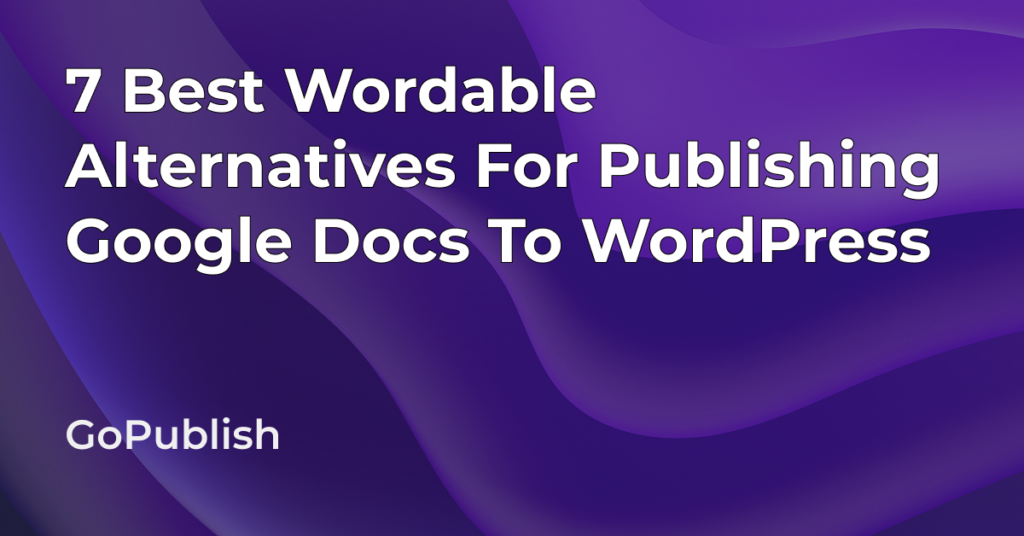You write in Google Docs. You publish in WordPress. Somewhere in between, things tend to break: formatting glitches, missing images, wasted time copying and pasting, and the constant back-and-forth between platforms. If you’re a content manager, SEO head, blogger, or agency founder, you know this pain all too well.
Enter tools like GoPublish.io and Cloudpress: Both are created to eliminate that friction and streamline the Google Docs to WordPress publishing workflow. Both claim to make your life easier. Which leads to the question: which one is right for you?
Let’s break it down.
What Do Both Tools Do?
At their core, GoPublish.io and Cloudpress are content automations tools that solve the same problem: publishing content from Google Docs (or Sheets) directly to WordPress. But how they go about it varies.
GoPublish.io
GoPublish.io is a Google Workspace add-on that lets you:
- Publish posts, pages, or custom post types from Docs to WordPress with one click
- Sync updates between Google Docs and your WordPress site (two-way sync)
- Retain all formatting, embeds, images, and links
- Use bulk publishing via Google Sheets
- Granular team access for easy collaboration
- Optimize for SEO inside Docs (titles, meta descriptions, permalinks, alt text)
Cloudpress
Cloudpress is a standalone platform where you:
- Write or import content into a dedicated editor
- Export or publish it directly to WordPress
- Manage workflows, team collaboration, and scheduled publishing
- Customize how your content appears on the front end
Both aim to simplify Google Docs to WordPress publishing. But their philosophies differ – and so do their strengths.
Features and Benefits:
Let’s break down how each platform stacks up feature-for-feature, so you can see exactly where they align and where they part ways.
Gopublish.io
1. One-click publishing from Google Docs
Your team doesn’t need to learn a new interface. Write in Google Docs, click “Publish,” and you’re done. Formatting, embeds, links, and even media remain intact.
2. Two-way sync
Make changes in WordPress or Docs—GoPublish keeps them in sync. Perfect for evergreen content that evolves.
3. Built-in SEO optimization
Handle SEO workflow like titles, descriptions, alt text, and permalinks directly in Docs. Auto-fill for Yoast and RankMath ensures SEO doesn’t get skipped.
4. Bulk publishing via Google Sheets
Ideal for high-volume publishing workflows. Upload dozens of pieces without repeating steps.
5. Full content type support
Publish posts, pages, or custom types like product descriptions or FAQs—with no formatting loss.
6. Image and embed intelligence
Compress images, retain filenames, apply alt text, and handle shortcodes and blocks without manual tweaks.
7. Team management at scale
Granular user permissions let large teams collaborate without stepping on each other’s work. No surprises. No access errors.
8. Dynamic content updates
Update existing content without duplication. Great for pricing tables, changelogs, and live content.
GoPublish builds itself around how content teams already work, not how they’re told to.
Start your free trial with GoPublish.io and export straight from Google Docs to WordPress in one click.
Cloudpress:
1. Multi-platform flexibility
Export from Google Docs or Notion to a variety of CMS platforms like WordPress, Webflow, Sanity, and Contentful.
2. Automation integration
Link to tools like Trello and Asana. When a task is moved to “Done,” Cloudpress automatically exports the attached doc to your CMS.
3. Formatting preservation
Supports rich formatting, including lists, tables, code blocks, and embeds. Also handles custom fields, tags, authors, and featured images.
4. Bulk export from web dashboard
Export multiple docs at once via their web app—suitable for bulk content publishing.
5. Media optimization
Images can be compressed, converted to WebP, and alt text preserved or overridden with custom directives.
6. Custom field mapping
Break content into multiple fields using processing directives—useful for structured layouts or headless CMSs.
7. Property Table management
Update tags, slugs, categories, and even raw HTML blocks directly from Google Docs using property tables.
8. Reliable support for Notion
For teams that use Notion, Cloudpress offers parallel export and automation features similar to its Google Docs capabilities.
Cloudpress is built for flexibility. It’s especially useful for cross-platform publishing and structured editorial workflows.
| Feature | GoPublish.io | Cloudpress |
| Direct Google Docs to WP | Yes | Yes |
| Two-way sync | Yes | No |
| SEO Tools Built-in | Yes | Yes |
| Custom Post Type Support | Yes | No |
| Bulk Publishing | Yes (via Sheets) | Yes (Web dashboard only) |
| UI Familiarity | Native Google Docs | Proprietary Editor |
| CMS Platforms Supported | WordPress only | Multiple (WP, Webflow etc) |
| Collaboration Workflow | Docs-native | Platform-based |
| Customer Support | Chat, Email, Call Scheduling – for all plans | Email only – for all plans |
| Reviews / Ratings | 5⭐(G2 and Google Marketplace) | No Ratings on any public platform |
Pros and Cons
No tool is perfect. Here’s a quick rundown of what each platform does well and where it might fall short depending on your needs.
GoPublish.io
Pros:
- Native Google Docs experience (no new editor to learn)
- Two-way sync saves tons of time
- Built-in SEO tools
- Google Sheets integration for bulk content
- Lightweight and fast
- Allows granular team access
- No WordPress security issues since it’s a Google Doc add-on (not a plugin)
Cons:
- Best suited for WordPress publishing only
Cloudpress
Pros:
- Good for teams with multi-step workflows
- Custom field mapping for advanced users
- Supports multiple CMS platforms beyond WordPress
Cons:
- Separate editor can feel redundant if you already work in Docs
- No two-way sync (changes in WordPress won’t update Docs)
- Slight learning curve for solo users or small teams
Still deciding? Try GoPublish.io risk-free 14-days free trial and experience how fast WordPress publishing can really be.
Pricing Comparison
Based on the features, both tools have priced themselves with different tiers:
GoPublish.io offers more affordable entry-level pricing:
- Free Forever: $0/month
- Starter: $9/month
- Professional: $19/month
- Agency: $49/month
- All plans are applicable for a hassle-free refund
Cloudpress offers two-tiers:
- Solo: $29/month
- Pro: $49/month
- No refunds policy
Value Analysis:
- GoPublish.io provides better value for budget-conscious users and small teams with its $9 and $19 tiers
- Cloudpress offers more features per dollar in their plans
- GoPublish.io has three tiers and a 30-day moneyback policy allowing more granular choice, while Cloudpress keeps it simple with just two options without any refunds.
- GoPublish.io supports unlimited website connections for its top tier plan, while Cloudpress caps CMS connections at 10 even on the Pro plan.
Which Tool is Ideal for Whom?
Both platforms shine in different scenarios. Here’s how to know which one fits your team’s workflow, tools, and publishing goals best.
Use GoPublish.io if:
- Your team lives in Google Docs
- You need fast publishing with minimal setup
- You want to retain all formatting without babysitting your posts
- You manage SEO directly inside your drafts
- You manage content for multiple WordPress Websites
- You prefer one-click publishing with Sheets or Docs
Use Cloudpress if:
- You work with multiple CMS platforms
- You need a more structured workflow with internal approvals
- You don’t mind using a separate content editor
- You’re already using other Cloudpress-compatible tools
What Makes GoPublish.io Stand Out?
Yes, GoPublish.io does offer lower price and faster publishing, but its actual benefit lies in the invisible savings:
- No learning curve: If you use Google Docs, you already know how to use GoPublish.io.
- Time back to your team: Fewer touchpoints. No switching tools. Real-time sync.
- Built-in SEO tooling: You don’t need to open WordPress or Yoast to optimize content.
- Scale-friendly workflows: Publishing 30 posts via Sheets? Done in minutes.
Here’s what GoPublish users have to say:
GoPublish.io fits seamlessly into what your team already does, without any added effort.
Final Word
Cloudpress and GoPublish.io both aim to solve the Google Docs to WordPress pain point, and they do. But they cater to different styles of working. Cloudpress builds its own workflow; GoPublish.io fits into yours.
If you’re already drafting in Google Docs and your main CMS is WordPress, GoPublish.io wins on speed, simplicity, and price. And it’s just an add-on simplifying your blog publishing process without any extra logins or new platforms to learn.
You want your content live and optimized – without friction. That’s exactly what GoPublish.io delivers.
Ready to stop copying and pasting from Google Docs to WordPress? Start your GoPublish.io trial now — no learning curve, just fast publishing.
FAQs
Q: Can I use GoPublish.io with a free Google account?
A: Yes, GoPublish.io can be used with a free Google account.
Q: Does Cloudpress support Webflow or Ghost?
A: Yes, Cloudpress supports multiple CMS platforms.
Q: Is there a trial version for GoPublish.io?
A: Yes, there’s a free trial available for new users.
Q: Can I revert changes after syncing content?
A: GoPublish.io lets you edit in Docs and push updates to WordPress anytime.
Q: Does GoPublish.io support scheduled publishing?
A: Yes, you can set publish times directly from the add-on.
Q: How is media handled in both tools?
A: Both retain images and formatting, but GoPublish.io uploads images directly to your WordPress media library.
Q: Is it safe for SEO teams?
A: Absolutely. GoPublish.io supports alt text, meta titles, and integrates with Yoast/RankMath.
Want to try GoPublish.io for your next post? Start your free trial and simplify your workflow.


